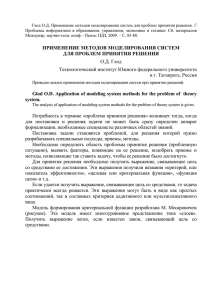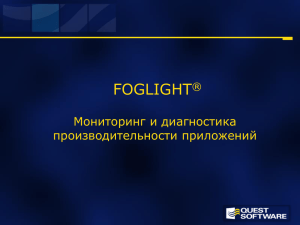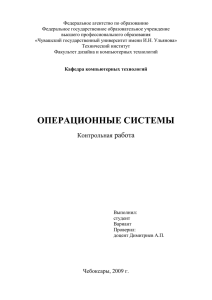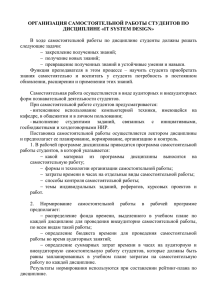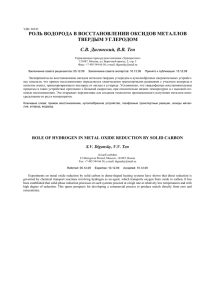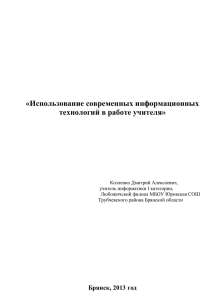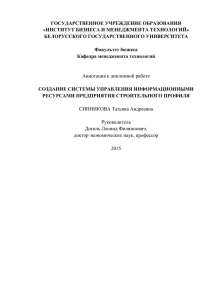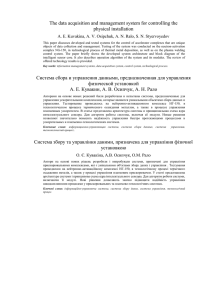Paradoxes of quantum and statistical mechanics.
advertisement

Paradoxes of quantum and statistical mechanics. Dr. Kupervasser Oleg Истечение газа из сопла. Показаны, в увеличенном размере, на самом деле невидимые невооруженным глазом молекулы газа . Пример неустойчивости Contradiction between second law of thermodynamics and reversible laws of • • • • classical physics. Second law of thermodynamics: Macroscopic Entropy (Coarsened Microscopic entropy) of closed isolated system can only increases and achieves its maximum in thermodynamics equilibrium state. Microscopic entropy is always constant in classical physics but Macroscopic Entropy can increases and also decreases. Poincare’s Paradox Zermelo’s Paradox Four main components of full system. • Observed system (microscopic, mesoscopic or macroscopic) • Surround medium • Observer + memory Macroscopic entropy increasing paradox resolution. • Definition of time arrow in Macroscopic entropy increasing direction. • For observed system: Synchronization of time arrow of observed system with time arrow of surround memory and observer time arrow is a result of small uncontrolled interaction and instability of decreasing entropy processes. • For a full system: impossibility of selfobservation (impossibility of self-observation of returns). Memory erasing during returns. Две причины, приводящие к несоответствию реальных законов движения законам классической и квантовой динамики. Это внешний шум и погрешность начальных условий. Эти факторы приводят к разрешению парадоксов в квантовой механике и классической статистической физике. Они объясняют отклонение от законов идеальной динамики в этих парадоксах. . Состояние с противоположными стрелами времени у двух подсистем неустойчиво. Малое взаимодействие между системами приводит к синхронизации стрел времени. Поэтому всюду во Вселенной стрелы времени сонаправлены. Положительное направление стрелы времени идет в направлении роста энтропии. Поэтому энтропия повсюду во Вселенной только растет. Возврат системы к исходному состоянию из-за корреляций. Этот возврат не может быть зафиксирован при самонаблюдении из-за стирания памяти. Разлетающиеся электрон и позитрон в ЭПР парадоксе. Схема интерференционного опыта Юнга. Дифракция электронов на двух щелях. Мячики, пролетающие сквозь щель в заборе, оставляют на стене следы в виде двух полос — «изображения» щелей. Так же вел бы себя и свет, будь он просто потоком частиц. Contradiction between reduction of wave function and Schrodinger law (Unitary evolution) of quantum mechanics. • Microscopic entropy is constant under Schrodinger law but increases under reduction. • Schrodinger cat paradox as illustration of wave function reduction paradox. Опыт со Шредингеровским Котом с точки зрения внешнего наблюдателя и с точки зрения самого Кота (самонаблюдение) Пример квантовой суперпозиции макросостояний. Four main components of full system. • Observed system (microscopic, mesoscopic or macroscopic) • Surround medium • Observer + memory Schrodinger cat paradox resolution. • For a observed system: reduction happens because of non closed character of system: 1) small uncontrolled interaction with surround medium (decoherence process) 2) necessary for measurement interaction with observer • For a full system: reduction happens because of impossibility of self-observation (selfobservation of returns). Memory erasing during returns. Возврат системы к исходному состоянию из-за квантовых корреляций между «Мирами» в Многомировой интерпретации. Этот возврат не может быть зафиксирован при самонаблюдении из-за стирания памяти. Прямой и обратный процессы Analogy between quantum (QM) and classical mechanics (CM). • Similarity in paradoxes resolution • Analogy between reduction process and “molecular chaos hypothesis” (MCH) F(x1,x2)=F(x1)*F(x2): 1) Nondiagonal elements of density matrix in QM and correlations in CM dissapearing 2) Entropy increasing • Main Difference between QM and CM: It is not probabilistic character of QM. Observation in QM is impossible without some small interaction even for macroscopic system. In CM it is possible. Definition of same uncontrolled small interaction in CM make this difference unimportant. CM in this case is also probabilistic. Real and ideal dynamics. • Impossibility of full description for observed and full system. • Microscopic and macroscopic variables and master equations (obtained by reduction or MCH): Real and ideal dynamics • Unfalsifiability (in Karl Popper’s sense) of difference between Real and ideal dynamics for full system • Practical Unfalsifiability of difference between Real and ideal dynamics for observed system Unpredictable dynamics. • Quantum computers as example of Unpredictable dynamics for external observer which doesn’t know initial state. Mesoscopic isolated systems • Mesoscopic Classical systems with returns as analogy of Quantum computers. Mesoscopic fluctuations. • Open Living systems as example of Unpredictable dynamics. Very unstable correlation inside of organism and with outside world in CM (or nondiagonal terms of density matrix in QM) conserved by metabolism processes. • Phase transition (bifurcation points) Схема квантового компьютера
